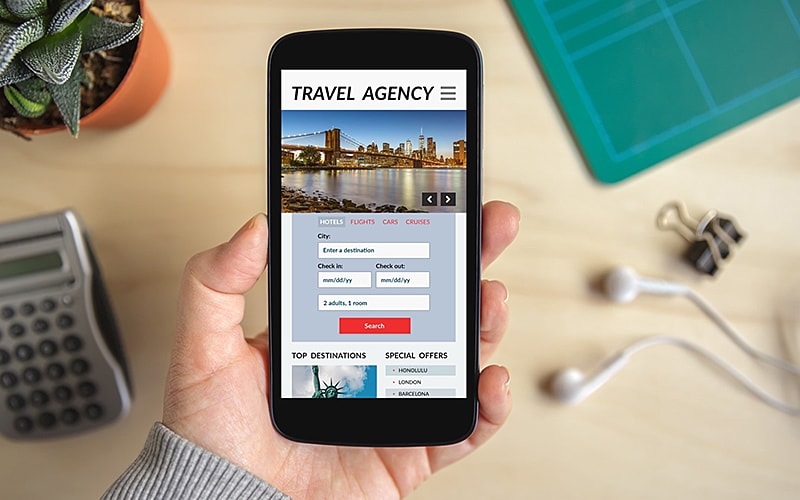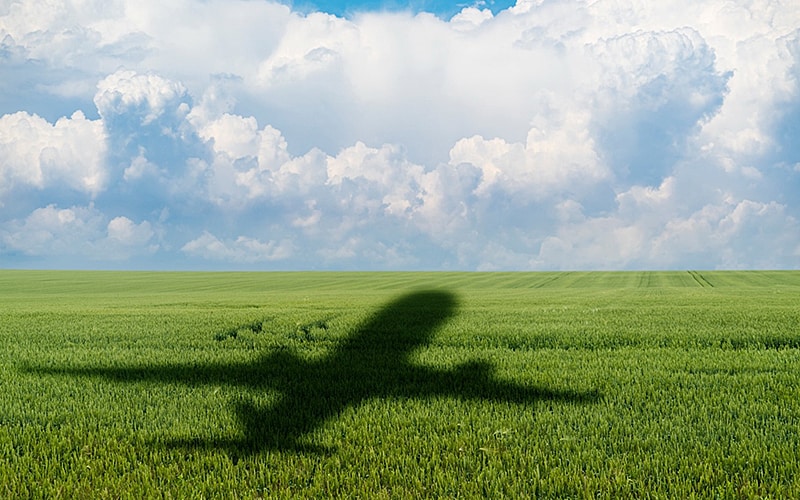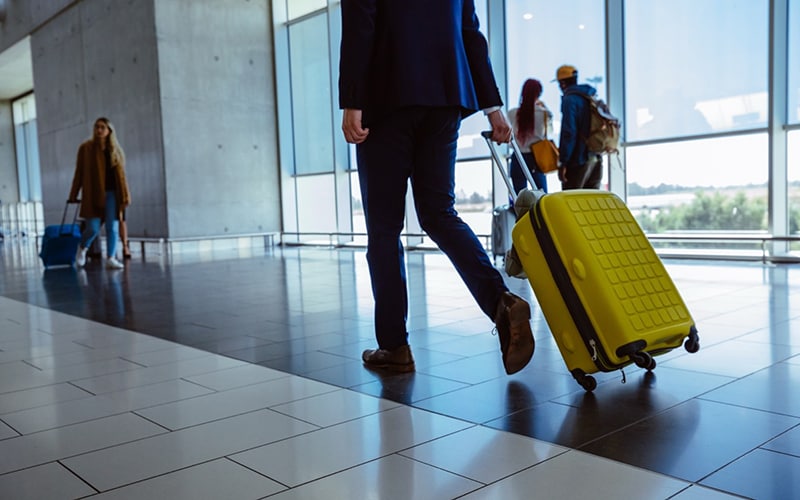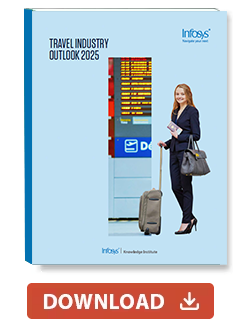Insights
- Asia-Pacific expansion, higher disposable incomes, and a surge in experiential travel are driving growth in the global travel market.
- Regulatory shifts are reshaping operations. Mergers and acquisitions (M&A) activity and industry consolidation reflect a focus on technology integration and market expansion.
- Technology adoption, including AI, contactless payments, and sustainable fuels, is enhancing experiences, boosting efficiency, and supporting revenue growth amid ongoing digital transformation.
Executive summary
International travel saw a surge after the end of the pandemic. It continues to grow, fueled by travelers who missed out during Covid and who now consider travel more important than ever. However, according to the UN Tourism Panel of Experts, ongoing economic and geopolitical uncertainties threaten this growth in tourism and traveler confidence, prompting people to place greater emphasis on value for money when planning trips.
Yet demand for travel is expected to stay resilient. In 2024, average spending per international trip held steady at $1,170, remaining well above the pre-pandemic average of $1,000. Research shows that 74% of global respondents were planning between one and three domestic trips in 2025, while 59% intended between one and three international trips. As the year moves to its close, travelers have ended up balancing exploration at home with experiences abroad. The coming year will be one where they continue to seek value, and exchange rates will play a decisive role in their choice of destinations. Destinations like Asia, where rates are more attractive, are likely to draw a stronger influx of tourists.
By 2026, Asia-Pacific (APAC) is expected to welcome 762 million international visitors, up from 619 million in 2024 — equivalent to 111.6% of pre-pandemic levels. Between 2024 and 2026, Asia is forecast to contribute the largest share of growth in international travel, with the Americas and the Pacific trailing behind, reinforcing APAC’s position as the world’s fastest-recovering and thriving travel region.
The travel industry isn’t devoid of challenges. Some of the biggest challenges in 2025 have included climate change and related environmental impacts including wildfires and heatwaves; overtourism, especially during peak tourist season; threats to cultural and biological diversity, and security risks in a tense geopolitical climate. Persistent labor shortages remain a challenge, driven by a widening skills gap, workforce shifts during the pandemic, and talent migration to higher-paying tech jobs.
Relying on technology such as artificial intelligence (AI), augmented and virtual reality, and automation that reduce the dependency on humans can help solve some of these issues. That said, it is imperative for organizations to ensure the reskilling of employees to use these technologies, particularly AI, effectively.
Financial insights
Market size and CAGR
The travel market is projected to expand by $2.8 trillion, growing at a compound annual growth rate (CAGR) of 11% from 2023 to 2028. As per UN Tourism, APAC is growing significantly — international tourist arrivals rose by 5% in Q1 2025 compared to the same period in 2024. The rise of Asia’s middle classes, especially in India and China, rapid urbanization, diverse destinations, and upgraded transport infrastructure are driving strong growth in both leisure and business travel across the region. The surge in experiential travel is reshaping the market, with travelers favoring authentic, immersive experiences over conventional tourism. The rise of social media has amplified this trend, as easily shareable, experience-driven content attracts strong audience engagement.
Revenue
In the first quarter of 2025, international tourist arrivals topped 300 million, up by 14 million from the same quarter in 2024. Global travel demand stayed resilient at the start of 2025, holding firm against geopolitical and trade headwinds. Industry experts felt a cautious optimism in terms of the industry’s outlook for May to August 2025, even as persistent economic and geopolitical pressures create risks for tourism’s resilience. Yet the global travel and tourism market is set for strong growth, with revenue expected to reach $988.5 billion this year and expand at a CAGR of 7.07%, hitting $1.3 trillion by 2030. Sales via online channels are projected to generate 76% of the total revenue in the travel and tourism sector by 2030 due to the convenience associated with it for travelers.
Market spending
The travel advertising market was valued at $10.1 billion in 2024 and is forecast to more than double to $20.5 billion by 2032, at a steady CAGR of 8.6%. This expansion is being shaped by several forces. AI-driven hyperpersonalization is redefining customer engagement, making ads smarter, more relevant, and more interactive. Online sales account for 69.6% of worldwide travel and tourism revenue, and the rise of digital and mobile channels has transformed how travel brands connect with consumers, enabling highly personalized and data-driven campaigns. Social media platforms have become central to travel marketing, with influencer collaborations and user-generated content amplifying reach and authenticity.
The pandemic saw the travel industry’s media ad spend fall by almost 60%. It recovered in 2024, when travel companies spent $9.86 billion on advertising, a small increase from 2019’s $9.85 billion. The industry’s growth led to the increase in media ad spending.

Industry dynamics
Major travel booking platforms achieved a 21% CAGR in revenues between the financial years 2022–2023 and 2024–2025 (Figure 1), which indicates strong and sustained growth in travel globally. Research involving high net worth individuals across geographies shows that 68% of respondents would likely spend more on leisure travel in the 12 months from May 2024, with 70% looking at traveling within Asia-Pacific. There is an increase in inbound and outbound tourism in Asia (Figure 2), owing to expanded flight connectivity and growth in luxury travel. Countries such as Thailand, Japan, China, and India are easing entry rules and expanding visa-free travel to draw international tourists and digital nomads. Thailand is projected to welcome 40 million international visitors in 2025, underscoring its strong tourism recovery, and appeal as a global destination. Travel bookings for June to September 2025 show the biggest year-over-year growth in Tokyo and Osaka. This signals a shift in global tourism, with nations adopting more open, tourism-driven strategies and using easier access as a competitive edge to capture a bigger share of travelers. To make the entry easier for visitors, Japan has launched the Japan eVISA, an online system that lets nationals of countries like Australia, Brazil, Cambodia, Canada, Saudi Arabia, South Africa, Taiwan, UK, and US apply digitally for short-stay tourist visas. It has also eased visa rules for Chinese travelers, related to multiple entry and extended stays. TV shows such as The White Lotus (filmed in Thailand), Expats (filmed in Hong Kong) and Squid Game (filmed in South Korea) could be sparking fresh interests among travelers.
Figure 1. Revenue growth witnessed by major travel booking platforms
Source: Refinitiv
Figure 2. APAC is witnessing a steady growth in travel
Source: UN Tourism
Mergers and acquisitions
In the first quarter of 2025, travel and tourism deals dipped slightly, down about 5% from last year. While venture funding and private equity slowed, M&As picked up a little, showing that investors are being more selective but still see opportunities in certain regions despite global economic shifts.
One of the major deals included Sabre’s $1.1 billion sale of its hospitality unit to asset manager TPG. The sale lets Sabre optimize its portfolio, double down on its core travel distribution and airline IT solutions, streamlining operations and sharpening strategic focus. Other transactions include those by travel tech companies, such as Lighthouse — the commercial intelligence platform designed for the travel and tourism industry — acquiring marketing tech company The Hotels Network, and revenue management software provider Duetto buying HotStats. In parallel, travel distribution solutions platform Juniper extended its acquisition streak with RezMagic, while B2B travel technology marketplace HBX announced the purchase of Civitfun. Experts note that technology consolidation in travel is largely driven by companies seeking to boost revenue, broaden their product portfolios, build end-to-end platforms for clients, and extend their reach across new geographies.
P&O Cruises Australia was absorbed into Carnival Cruise Line in March 2025. The shift toward M&A over private equity and venture financing suggests that established players are consolidating and strengthening their market positions, as seen with Carnival’s absorption of P&O Cruises Australia, rather than relying on new entrants or high-risk capital.
Regulatory changes
Like all industries, travel is subject to regulations shaped by security, health policies, immigration, diplomatic relations, data privacy, consumer protection, and economic factors. New regulations incoming include the EU’s Entry/Exit System (EES), which is set to launch in October 2025, with a phased rollout continuing until April 2026. Designed to digitize border control across the Schengen area, the system will replace manual passport stamping with biometric verification such as fingerprints and facial recognition, storing the electronic data in a central database to track and manage the movement of non-EU nationals. While the move is expected to lead to shorter queues, reduced waiting times, and smoother travel, its effectiveness will only become clear once fully implemented.
The European Travel Information and Authorization System (ETIAS), scheduled for launch in late 2026, will apply to nationals of 59 visa-exempt countries, including the US, UK, Canada, and Australia, visiting 30 European destinations for short stays. As part of a pretravel authorization, travelers will need to complete an online application, pay a nominal fee, and receive approval electronically linked to their passport. These regulations will require travelers to be well-prepared and up to date on the rules to avoid disruptions.
The ReFuelEU Aviation regulation requires all flights departing EU airports to use at least 2% sustainable aviation fuel (SAF), with the share rising to 70% by 2050. As part of the EU's Fit for 55 package, its objective is to lower aviation emissions by replacing conventional jet fuel with sustainable alternatives such as biofuels, synthetic fuels, and recycled carbon fuels. While SAF can cut carbon emissions by up to 80% over the full life cycle, travelers could face higher ticket prices since SAF remains costlier by two to three times compared to traditional jet fuel, SAF made up only 0.3% of global jet fuel production in 2024, a level the International Air Transport Association (IATA) described as “disappointing.” The share is expected to edge up to just 0.7% this year. Airlines maintain that expanding the SAF ecosystem will only be achievable through close collaboration with a wide range of partners, including airlines and operators.
Regulators in the US and EU have introduced stricter refund timelines and clearer cancellation policies, ensuring that travelers receive timely compensation for delays or cancellations. While the EC261 regulation improves passenger protection, airlines could face increased operational and administrative costs to comply with the new rules. According to Carsten Spohr, chief executive of Lufthansa Group, passengers are footing a higher bill under EU261 than the profits airlines themselves are able to generate. Stricter rules on price transparency and refund policies are compelling businesses to present all costs and conditions upfront to stay both competitive and compliant. Beyond regulatory demands, sustainability commitments are also reshaping the landscape. Together, these forces open the door to innovation and more seamless traveler experiences, but they also bring new pressures — pushing the industry to strengthen its technology infrastructure, enhance compliance frameworks, and rethink operations. For many players, this means not just meeting legal requirements but also differentiating through trust, clarity, and sustainable practices.
Stricter rules on price transparency and refund policies are compelling businesses to present all costs and conditions upfront to stay both competitive and compliant.
Tourism to the US has fallen, with some commentators attributing the decline to policies introduced under President Trump, including tariffs and stricter immigration laws, the revival of a travel ban largely affecting African and Middle Eastern nations, tighter visa approval processes, and stepped-up immigration raids, impacting travelers particularly from countries such as India and China.
Talent management
Tourism employs over 270 million people worldwide, accounting for roughly 8.2% of the global workforce. But talent management remains a persistent challenge for the travel industry, as it continues to grapple with issues such as attrition. The travel industry has one of the highest employee turnover rates, possibly due to poor training, low wages, long hours, and demanding schedules, which erode morale. Providing benefits and having flexible work policies wherever possible can help companies stand a stronger chance of retaining top talent. Offering perks such as discounted travel and complimentary stays can also help. Upskilling employees in new technologies, particularly AI, is crucial for them to adopt the technology. Infosys’ Future of Work report states that a 20% increase in skills application is associated with revenue and profit uplift of 0.6 percentage points. For large businesses across the US, UK, France, Germany, Australia, and New Zealand, this translates into a potential $66 billion increase in revenue and $14 billion in profit, demonstrating the tangible financial returns that can be unlocked through more effective employee training.
Trends
Experiential travel
The demand for niche travel is growing, as tourists look for unique and specialized experiences — adventure, culinary, or cultural — tailored to their interests rather than generic travel packages. Recent research explored the aspects travelers consider when choosing a destination: travelers highlighted the importance of experiencing authentic local customs and culture when making their decisions.
Wellness tourism, favoring destinations focused on relaxation, fitness, and healthy eating, is catching on. Namibia, South Africa, and Thailand top the Wellness Travel Index (WTI) from MEI, recognized for wellness offerings like eco lodges and meditation retreats. Noctourism is also emerging as a popular trend, offering immersive nighttime experiences such as late-opening museums, night game drives, bioluminescent beaches, stargazing, and aurora viewing.
The rise of social media, particularly Instagram and TikTok, is driving the popularity of experiential travel, as travelers turn to social media for inspiration. In fact, 75% rely on it as a key source of travel ideas and look to shared posts and reviews to guide their choices of destinations. To benefit from the demand for experiential travel, travel companies need to track trending experiences, attract travelers with effective marketing, and provide offerings that leave a lasting impression.
Unbundled fares
Airlines are increasingly unbundling services that were once included in the ticket price. These include checked baggage, seat selection, in-flight meals, and priority boarding, which used to be standard, and are now often offered separately for an additional fee. This offers customers more flexibility as they can pay the basic fare associated with a ticket and add on services based on their preferences. This approach can also make premium travel more affordable in some cases — for example, a business class ticket that previously included numerous extra services, beyond the standard seat and priority boarding, can now cost less when those services are offered à la carte. Qatar Airways and Singapore Airlines have introduced unbundled business class fares in recent times. This feature allows airlines to extend themselves to customers with varying budgets and maintain transparency around the pricing.

Modern airline retailing
This refers to the complete life cycle of an offer, spanning presale, purchase, and payment settlement, and relies on technology, dynamic pricing, and personalization to enhance the flight shopping experience. Airlines personalize their marketing and travel offers based on real-time data synchronization of the traveler’s history and preferences, aimed at increasing customer loyalty. This includes better search results, automated order management for the airline, and seamless self-service. With AI-driven offer management, airlines can tailor offers to each traveler, delivering the right options at the right moment. Moving beyond generic deals, they can create bundles and ancillary services designed to align with individual passenger preferences. AI-powered platforms help automate intricate pricing rules, cutting down on manual effort and errors.
A survey of airline employees shows that eight out of 10 respondents view modern retailing transformation as a strategic move with high value-creation potential for their airline. Most airlines are still transitioning to using it in their order management, but 70% of survey participants are confident that IT vendors are well-prepared to provide solutions that facilitate legacy-free offers and orders.
To remain competitive, airlines will need to implement modern retailing strategically across the value chain, harness generative AI, and align with the right technology vendors who can support them in their journey.
Bleisure travel
A study shows that younger employees value the option of blended or bleisure travel, which is mixing business trips with personal time at the destination. With travellers driven by a sense of recouping lost time, revenge travel — trips postponed because of the pandemic — has become a notable post-pandemic trend. This could be why travelers are keen on combining work trips with taking a break at the destination. Flexible working styles that have seeped into corporates across industries could fuel this trend further.
Technology outlook
Artificial intelligence
Research shows that most (84%) C-suite executives across industries, including travel, consider AI central to reaching their growth objectives. AI-driven booking systems and chatbots that offer personalized recommendations and custom itineraries are becoming crucial for attracting and retaining customers. Survey results show that younger travelers see generative AI as most useful for practical and personalized support — ranging from activity recommendations (40%), expense management (36%), translation assistance (33%), and personalized trip recommendations (33%).
Beyond operations, AI supports revenue optimization, enabling companies to fine-tune prices in real time. From Tripadvisor using generative AI to craft tailored travel itineraries, to airports phasing out paper tags in favor of AI-enabled baggage sorting, the industry is embracing AI at multiple touchpoints. AI is also being used for surveillance via AI security cameras in airports to detect real-time threats, particularly with rising terrorism risks. It can also help detect and prevent cyberattacks, one of the major disruptions for the travel industry.
AI-powered video analytics and agentic AI tools are being used to analyze the behaviors, preferences, and booking histories of individual customers, and use the insights generated to develop personalized recommendations tailored to the traveler. It helps achieve savings related to workforce costs. Combined with big data, AI can help the travel industry in revenue management purposes. It can help better anticipate levels of demand based on past trends, to optimize pricing and promotional strategies.
Delta is shifting to an AI platform that acts like a real-time analyst, continuously processing streams of data to predict the fares individual passengers are most likely to accept. Instead of relying on fixed prices for routes or seat classes, the system dynamically simulates willingness-to-pay, tailoring offers to each traveler and moment. The goal is to replace static pricing with adaptive, passenger-specific fare strategies. Finnair is applying AI-driven predictive analytics to anticipate and reduce unplanned aircraft maintenance, improving turnaround times between flights. It’s also using an HR chatbot to support employees with their policy and benefits queries, and a customer chatbot to deliver tailored travel experiences, such as suggesting destinations aligned with individual profiles.
Airline safety lapses have drawn global attention in the recent past. Predictive technologies enable airlines to foresee maintenance requirements and proactively schedule preventive upkeep, reducing downtime and operational disruptions. AI algorithms can analyze aircraft sensor data in real time to detect potential mechanical issues before they become critical, reducing the risk of in-flight failures. AI can continuously monitor flight parameters and identify anomalies or patterns that might indicate safety risks, helping airlines proactively address them, making the technology doubly useful for the travel sector.
However, it’s not clear if AI is delivering benefits for the travel and hospitality industries despite these potential use cases. Infosys’ AI Business Value Radar shows that travel and hospitality sit in the bottom half of the viability ranking, in terms of its viability score — defined as the likelihood that its AI deployments will achieve all business objectives (Figure 3). This could also be stemming from outdated systems and fragmented data in the travel industry, combined with strict regulatory requirements that add complexity and slow down innovation. Also, the travel industry still depends heavily on human involvement and physical assets or brick-and-mortar locations to deliver services which could be holding it back, as opposed to other industries such as professional services, life sciences, and high tech which are more technology-driven and less dependent on human resources.
The research found sustainability to be the most viable category of AI use case (Figure 4) with supply chain transparency, energy optimization, material reuse, and circular economy/products being leading AI opportunities for travel and hospitality within it. AI can forecast demand, optimize heating/cooling, schedule charging for EV shuttles, and fine-tune aircraft routing for fuel efficiency, to optimize energy. Airlines, hotels, and cruise lines depend on sprawling global supply networks whether they’re related to fuel, catering, linens, or construction materials. AI can map supplier data and trace materials end-to-end, helping companies prove responsible sourcing to regulators and customers, while also spotting inefficiencies that drive costs.
AI can map supplier data and trace materials end-to-end, helping companies prove responsible sourcing to regulators and customers, while also spotting inefficiencies that drive costs.
Figure 3. Travel has a low viability score compared to other industries
Source: Infosys Knowledge Institute
Figure 4. Travel and hospitality companies employ AI effectively more often in sustainability
Source: Infosys Knowledge Institute
Contactless and flexible payments
Emphasizing safety and convenience, contactless payments are becoming more prevalent in various travel sectors. Contactless payments are on the rise, with the global market expected to grow from $10.3 billion in 2020 to $17.9 billion by 2025, at a CAGR of 11.7% in that period. Almost half of global consumers say they would forgo a purchase if they couldn’t pay using contactless methods. By integrating QR codes and NFC technology into mobile applications, businesses can simplify operations and provide a smoother user experience. Contactless travel is spreading quickly across Europe, with train and bus companies offering digital booking systems. Travelers can now purchase tickets ahead of time and access them instantly on their phones or via email, reducing the need for paper and queues.
Flexible payment options such as Buy Now, Pay Later (BNPL) and installment plans that ease budget pressures for travelers are also popular. More travelers are booking trips on BNPL plans, with Gen Z at the forefront. Global travel companies such as Expedia, Opodo, and MakeMyTrip are teaming up with BNPL platforms such as Klarna and LazyPay to make flights, hotels, and tours more affordable and flexible.
Studies show that over 10% of travelers are willing to increase their travel spend when flexible payment options are offered, and loyalty rewards remain important, with 14% of travelers preferring providers that offer strong rewards programs.

Sustainability technology
Some aircraft the world over are being powered by biofuels, which help to reduce the environmental impact of each flight. Beyond this, the aviation industry at large is exploring electric aircraft, the possibility of using hydrogen fuel, and options to shift toward hybrid fuel so that customers can fly with greater confidence. KLM Royal Dutch Airlines is flying with sustainable aviation fuel to curb its carbon emissions. In Scandinavia, airports have successfully supported biofuel initiatives by investing in production facilities. While SAF has traditionally been costlier than conventional jet fuel, ongoing R&D is helping to reduce expenses and improve its economic feasibility.
Data analytics is enabling tourism businesses to measure sustainability performance more effectively by tracking their progress toward goals and guiding better decisions. By analyzing visitor data, destinations can balance tourist flows, ease pressure on local environments, and improve planning and resource allocation.
Carbon footprint tracking apps, such as Earth Hero and Klima, help travelers monitor, reduce, and offset the environmental impact of their activities in real time. They calculate the carbon footprint of activities such as travel, energy use, or purchases; show users where most emissions are coming from and recommend alternatives or lifestyle changes to lower emissions. The feedback given by such apps can help decrease carbon emissions of travelers by 23%.

Key takeaways
- To capitalize on market opportunities, businesses should focus on delivering personalized, authentic experiences that cater to the evolving needs of travelers. By staying attuned to these trends and addressing the challenges, companies can effectively position themselves in the competitive market landscape.
- AI is increasingly central to the travel and hospitality industry, with most C-suite executives viewing it as critical for growth, and applications ranging from booking systems and chatbots to personalized itineraries and generative AI tools. Businesses should leverage AI technologies, including generative AI and agentic AI, to keep up with competitors and to enhance customer experience. If they don’t, they’ll lag behind and lose out.
- Regulations around price clarity and refund policies mean businesses must clearly communicate all costs and terms to customers to remain competitive and compliant. While regulations and sustainability initiatives create opportunities for innovation and enhanced traveler experience, they also require the travel industry to invest in technology, compliance, and operational adjustments.
- The market faces challenges, including the growing threat from terrorism, which can deter travelers and negatively impact the industry. Companies must navigate these challenges by implementing robust security measures and fostering transparency to reassure customers.









